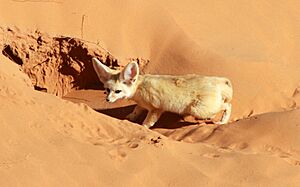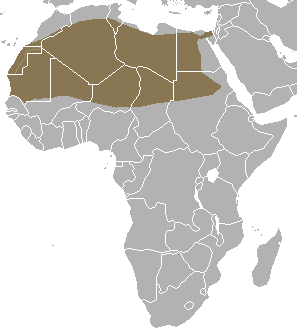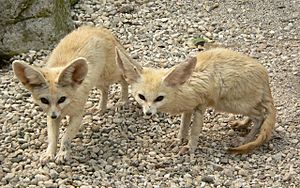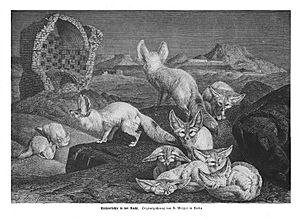Fennec fox facts for kids
Quick facts for kids Fennec fox |
|
|---|---|
 |
|
| Fennec fox in the Moroccan Sahara | |
| Conservation status | |
| Scientific classification | |
| Genus: |
Vulpes
|
| Species: |
zerda
|
 |
|
| Fennec range | |
The fennec fox (Vulpes zerda) is a tiny fox that lives in the deserts of North Africa. You can find it from Western Sahara to the Sinai Peninsula. These foxes are mostly active during dawn and dusk, which helps them avoid the hottest parts of the day.
Their most amazing feature is their super-large ears! These ears help them cool down in the desert heat. They also help the fennec fox hear tiny sounds from prey hiding underground. The fennec is the smallest type of fox. Its fur, ears, and even its kidneys are specially made for living in hot, dry places with little water.
Fennec foxes mostly eat insects, small mammals, and birds. They can live up to 14 years when cared for by humans and about 10 years in the wild. Their main enemies are large birds like the Verreaux's eagle-owl, jackals, and other big animals.
Fennec families dig big burrows in the sand to live in and stay safe. These dens can be as large as 120 m2 (1,300 sq ft) and sometimes connect with other families' burrows. We don't know exactly how many fennec foxes there are, but they are not currently in danger of disappearing. The fennec's fur is valued by local people, and some people keep them as exotic pets.
The name fennec comes from the Arabic word fanak (فَنَك), which means fox.
Contents
What Does a Fennec Fox Look Like?
The fennec fox has sand-colored fur. This special fur helps it reflect sunlight during the day. It also keeps the fox warm at night when the desert gets cold. Its nose is black, and its tail is long and bushy with a black tip.
Its long ears have reddish stripes on the back. The inside of their ears is covered with so much hair that you can't see the ear canal. The edges of their ears are whitish. Fennec foxes have the biggest ears compared to their body size of any dog family animal. These huge ears help them get rid of body heat and find small animals by sound.
They have dark lines that run from their eyes to the sides of their thin snout. Their large eyes are dark. The pads of their paws are covered with thick fur. This fur helps them walk easily on hot, sandy ground without burning their feet.
The fennec fox is the smallest animal in the dog family. Female fennec foxes are about 34.5 to 39.5 cm (13.6 to 15.6 in) long from head to body. Their tails are about 23–25 cm (9.1–9.8 in) long, and their ears are 9–9.5 cm (3.5–3.7 in) long. They weigh between 1 and 1.9 kg (2.2 and 4.2 lb). Males are a little bigger. They are about 39 to 39.5 cm (15.4 to 15.6 in) long with tails 23–25 cm (9.1–9.8 in) long and ears 10 cm (3.9 in) long. Males weigh at least 1.3 kg (2.9 lb).
Where Do Fennec Foxes Live?
Fennec foxes live all across the Sahara Desert. You can find them from Morocco and Mauritania to northern Sudan, and through Egypt and its Sinai Peninsula. They like to live in small sand dunes and wide, treeless sandy areas. These places often have a few plants like grasses, sedges, and small bushes.
How Fennec Foxes Behave
Fennec foxes are mostly active at night. This helps them avoid the extreme heat of the Sahara Desert. Being active at night also means they lose less water from panting. A fennec fox digs its den in the sand. They might choose open areas or spots protected by plants with stable sand dunes.
In hard-packed sand, their dens can be very large, up to 120 m2 (1,300 sq ft), with as many as 15 different entrances. Sometimes, different fennec families connect their dens or build them very close together. In soft, loose sand, dens are usually simpler. They might have only one entrance leading to a single room.
Fennec foxes that live with humans often stay in family groups. Young fennec foxes love to play and are very playful.
What Fennec Foxes Eat
Fennec foxes eat both plants and animals. Their diet includes small rodents, lizards (like geckos), small birds and their eggs, and insects. They also eat fruits, leaves, roots, and some tubers. They get most of their water from the food they eat, but they will drink water if they find it.
A fennec fox hunts alone. It digs in the sand to find small animals and insects. Some fennec foxes have been seen burying food to eat later. They also look for food near human homes.
In the Algerian Sahara, scientists studied 114 samples of fennec fox droppings. These samples contained over 400 insects, plant pieces, date palm fruits, and remains of birds, mammals, and other reptiles.
The Fennec Fox Life Cycle
Fennec foxes usually stay with the same partner for their whole lives. Fennec foxes living with humans can start having babies when they are about nine months old. They mate between January and April. Pregnancy usually lasts about 50 to 52 days, but sometimes up to 63 days.
After mating, the male fox becomes very protective of the female. He brings her food while she is pregnant and after the babies are born. Females give birth to one to four pups between March and June. The pups open their eyes after 8 to 11 days. Both the mother and father take care of the pups.
Fennec foxes communicate by barking, purring, yapping, and squeaking. The pups stay with their family even after new babies are born. The pups stop drinking their mother's milk when they are about 61 to 70 days old. Adult foxes care for their pups until they are about 16 to 17 weeks old. The oldest male fennec fox living with humans was 14 years old, and the oldest female was 13 years old.
Predators of the Fennec Fox
African horned owls, like the Pharaoh eagle-owl, sometimes hunt young fennec fox pups. There are also stories that caracals, jackals, and striped hyenas might hunt fennec foxes. However, local people say that fennec foxes are very fast and can change direction so well that even their hunting dogs can hardly ever catch them.
Threats to Fennec Foxes
In North Africa, fennec foxes are often caught in traps. They are then sold for shows or to tourists. As more human towns and cities grow in southern Morocco, fennec foxes have disappeared from those areas. They are now limited to living in less populated places.
Protecting Fennec Foxes
As of 2015, the fennec fox is listed as "Least Concern" on the IUCN Red List. This means they are not currently in danger of extinction. They are also listed in CITES Appendix II, which helps control their trade. Fennec foxes are protected in Morocco, Western Sahara, Algeria, Tunisia, and Egypt. They have been seen in several protected areas in these countries.
Fennec Foxes as Pets
The fennec fox is sometimes bred and sold as an exotic pet. People who breed them for sale often take the pups away from their mothers. This is so the pups can be raised by humans and become tamer, which makes them more valuable. A special registry has been set up in the United States for fennec fox breeders. This helps prevent problems that can happen when animals are bred too closely together.
Fennec Foxes in Culture
The fennec fox is the national animal of Algeria. It is also the nickname for the Algeria national football team, who are called "Les Fennecs."
See also
 In Spanish: Fénec para niños
In Spanish: Fénec para niños





